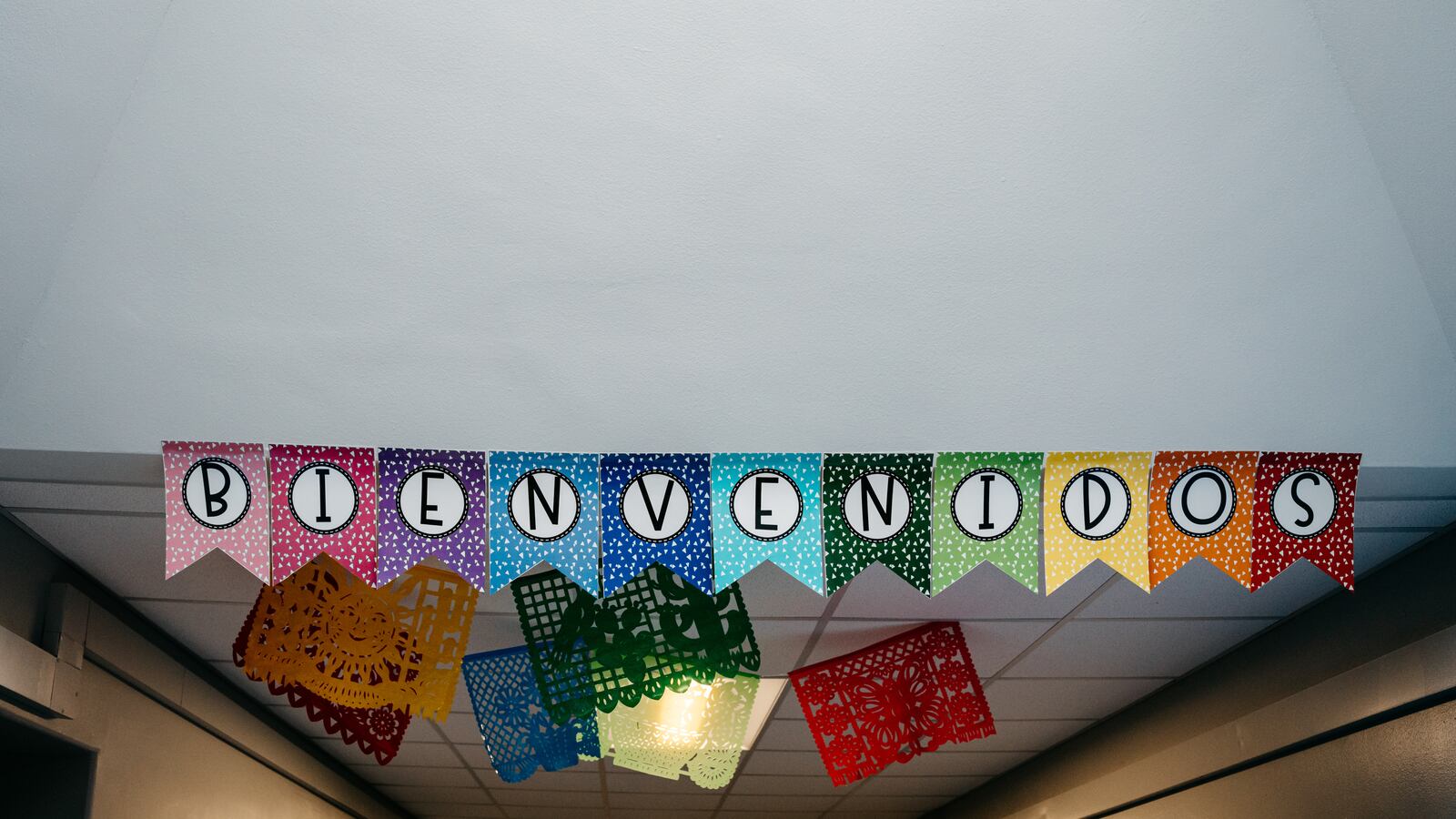Sign up for Chalkbeat Chicago’s free daily newsletter to keep up with the latest education news.
Viviana Ortiz is overwhelmed. As the only advocate for students experiencing homelessness at Cameron Elementary School in West Humboldt Park, she supports 126 students — a workload that has dramatically increased with the influx of migrant students from Latin America and other countries.
“The amount of support that our families need is incredible,” said Ortiz, who noted that she has never seen families in such need of clothing, food, and other necessities.
On Wednesday, Ortiz joined other educators, local and national union leaders, including Randi Weingarten, president of the American Federation of Teachers, and parents of new arrivals at a roundtable at Cameron Elementary School to call for more support for migrant students from federal, state, and local governments and to draw attention to the struggles of migrant families at Cameron and across the city.
Gabriel Paez, an English learner program teacher at Cameron and chair of the Chicago Teachers Union bilingual education committee, estimate that about 200 migrant students at the school need access to more bilingual education, transportation, and basic needs — a reflection of the wider challenges presented by the arrival of thousands of migrant families to the city.
As of Jan. 17, more than 30,000 migrants had arrived in Chicago since August 2022, according to a city dashboard. Most crossed the southern border and were ordered bused here by Texas Gov. Greg Abbott. Families and children are often fleeing countries that have seen a rise of violence and political strife.
At a City Council Education Committee meeting in November, a CPS official said the district had enrolled at least 4,000 migrant students.
Teachers at Cameron Elementary school said they have noticed some migrant students arrive at the school without proper clothing, such as coats warm enough for Chicago winter, and in need of medical support. Many are without permanent housing.
A spokesperson for Chicago Public Schools said the district has provided additional funding for staffing and services to help schools with the increase of newly arriving students. Nearly all migrant students have been classified as English learners or Students in Temporary Living Situations. CPS officials said they are currently working with the city, state, lawmakers, and the U.S. Department of Education to receive more funding.
At the roundtable, organized by the Chicago Teachers Union, participants echoed the call for more resources to help migrant students, including more bilingual teachers and staff.
In Chicago, the number of designated bilingual teachers has declined in recent years, but teachers with bilingual or English as a second language endorsements have increased, according to an analysis of staffing data by Chalkbeat Chicago. Another finding from the analysis found that the ratio of staff with bilingual credentials or titles to students was increasing as more English learners have enrolled.
At Wednesday’s roundtable, Paez said the district should push to cover 100% of tuition costs for educators who want to get a bilingual endorsement. He applauded the district for currently covering 50% of tuition, but said he wants to see teachers who want to get that endorsement not go into debt.
Paez also said the school needs more bilingual staff who can help students and families dealing with emergencies. Paez said he and other staff members at the school have gone above and beyond their duties to support students.
“Taking children to the ER is not in my job description, but we do it because the need is there,” said Paez. “If CPS, or the state, or the federal government could pay for someone to be in our building day in and day out whose only purpose is to help get these people on their feet, that will make the teaching and learning part of this equation a lot more manageable.”
State Rep. Lilian Jiménez, who represents neighborhoods on Chicago’s northwest side, noted that families who have migrated from Latin America need transportation and access to bus passes to get to school.
Chicago Public Schools has grappled with a bus driver shortage over the past few years. This school year, the district decided to only bus students who are legally obligated to have transportation — such as students with disabilities and those experiencing homelessness. This leaves out 5,500 students who used to get buses to and from the city’s magnet and selective enrollment schools.
Migrant students might not know that they are eligible for transportation if they don’t have access to stable housing under federal law. The law also says students can stay enrolled at the same school even if they have to move to another shelter.
In November, Gov. J.B. Pritzker allocated $160 million to the Illinois Department of Human Services to address the ongoing migrant crisis, with $65 million going to the city to help set up a winter shelter. With state lawmakers kicking off the spring legislative session this week, advocates are hoping for more money to support families who have migrated to the United States.
Jimenez said she’ll work throughout the spring session to get more tuition reimbursement to help teachers get a bilingual education endorsement.
CTU President Stacy Davis Gates called on the federal government to support Chicago during the migrant crisis as the city and district lack the infrastructure to assist migrant families.
“We need our collaboration to extend beyond the city. The city is not set up to deal with an immigration crisis. We do not have the infrastructure,” said Davis Gates. “So, this idea that we are just going to focus in on what isn’t here, let’s focus on who is supposed to bring the things that we need here.”
Samantha Smylie is the state education reporter for Chalkbeat Chicago, covering school districts across the state, legislation, special education, and the state board of education. Contact Samantha at ssmylie@chalkbeat.org.

